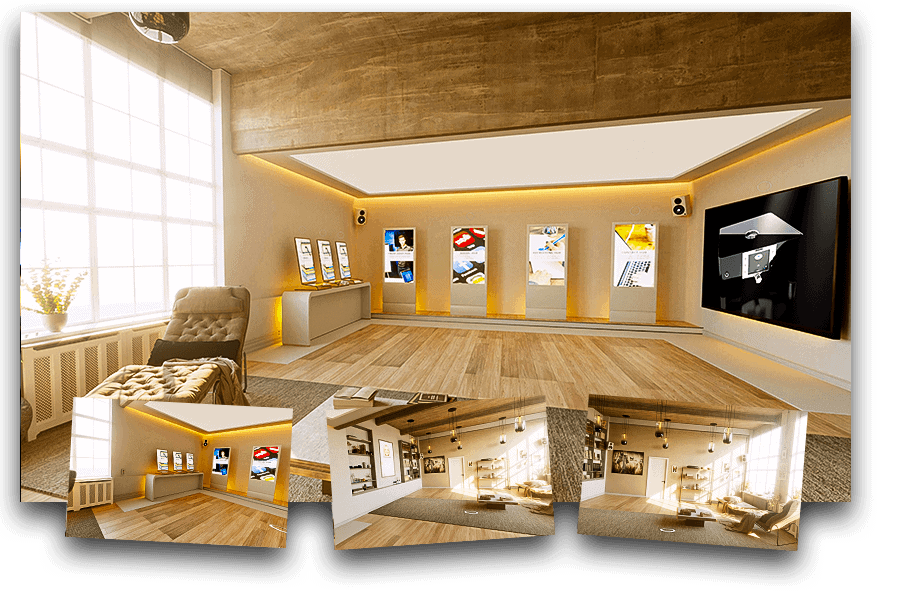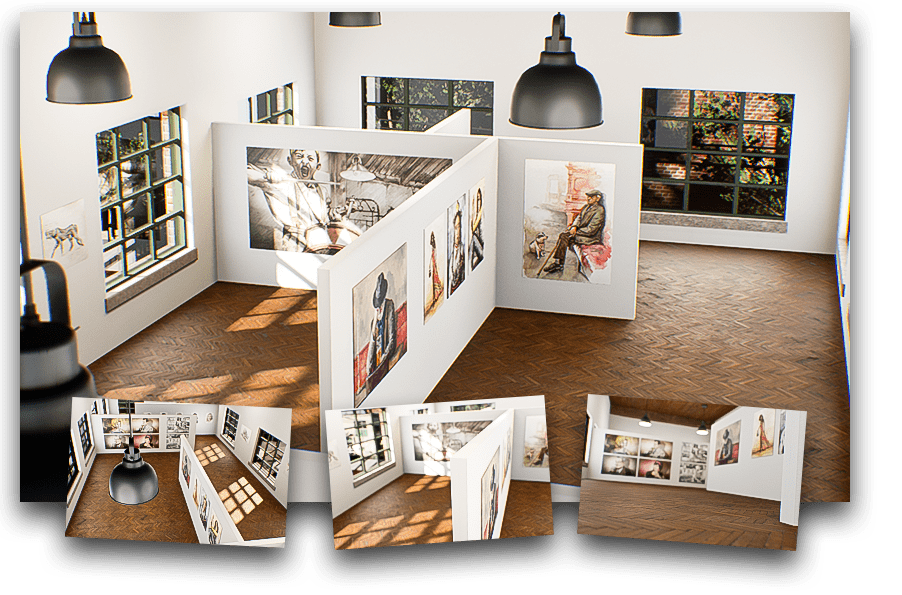At least since the global pandemic forced us to live a completely new way of life and we can no longer easily meet for a beer in the pub or at the annual industry fair or event, it has been clear that our channels of interaction must be expanded on a digital level, so that what we love and need can continue to take place as well as possible.
With our virtual room concepts, we can help you to style and package your digital meetings, virtual trade fairs and other events according to your taste so that your participants or visitors do not have the feeling of simply visiting a website again.
For hybrid events, the real and the virtual level can be merged even better. This is also a feature with added value for a world after Corona.

Some call it an escape from reality. We call it: an expansion of perspective.
As artificially designed spaces, virtual worlds and events complement our analogue reality.
In the gaming area, of course, this does not surprise anyone. But beyond that, virtual events are still largely uncharted territory, the exploration of which is only now picking up speed in the wake of the corona pandemic. The need for interaction with other people in digital space is increasing. And it should be interesting, lively and “somehow” depict what otherwise happens in real life. And that works … exactly, with virtual worlds and virtual events.
If we strip it of any creative and aesthetic garb and look at the bare technical facts, a virtual world or a virtual event is nothing more than a computer-aided, simulated environment.
Depending on the characteristics and design, you can move and communicate with avatars alone or in interaction with others. The avatars can be 3-dimensional figures, two-dimensional graphic representations or they can be purely text-based. In very elaborately designed virtual worlds and events, the avatars can also have sensory perception (especially the sense of touch).
In addition to the term “virtual world”, the terms “virtual reality” and “augmented reality” are also important in this context. Virtual worlds and virtual reality can roughly be understood as synonymous. Augmented Reality, on the other hand, has to be distinguished from it because it supplements the real, perceived world with virtual elements. The real world is not completely hidden in augmented reality, unlike in virtual reality or virtual worlds.
Most of the time, virtual worlds and virtual events can be found in the gaming area. In particular, games from the category of MMORPGs (massive multiplayer online role-playing games) are to be regarded as virtual worlds; but single player games can also have the character of a virtual world.
The use outside of the gaming industry, the transfer to new contexts, is of course interesting for us. Medical research at universities and in independent research centers has been working on virtual worlds for therapeutic purposes for some time. This can range from virtual therapeutic swimming with dolphins to treating Alzheimer’s patients. Often, however, film material from the real world is used for these virtual worlds and events; no “artificial” spaces are then created.
It is only very recently that the first attempts have been made to transfer virtual realities to the event industry. Wir sind stolz, mit der Open Digital City (ODC) als Marketing- und Eventstadt einen der ersten Use Cases für eine komplett virtuelle Version von Offline-Messen und Events im Bereich Marketing geschaffen zu haben. The virtual event of the ODC is growing and flourishing and is constantly evolving. Because, as in the real world, there must be development dynamics in the virtual world if users are to remain captivated by it in the long term.

Now what is this metaverse thing that everyone is talking about now? It’s simple: it’s the big (virtual) whole. Well, maybe that’s a bit under-complex to put it. The sum of all virtual worlds, virtual events and augmented reality settings constitute the metaverse. Originally, the term “cyberspace” was used for what is now called a metaverse. “Cyberspace” was used more and more as a synonym for “Internet”. Metaversum rather means the next level of the Internet, which is based on virtual worlds. If you read more than two sources on the subject, you will quickly notice that the term “metaverse” also has some blurring and is used with slightly shifted nuances of meaning.
The term originally comes from the cyberpunk novel “Snow Crash” by Neal Stephenson from 1993. Although it is widely said that he anticipated the future with his book, Stephenson claimed in a 2017 interview that he was just making it up. Probably – but nevertheless we see exactly this becoming (virtual) reality today!
Admittedly, a lot of people don’t (yet) use VR glasses to explore virtual worlds, events and realities. That should change soon, however. Because the VR glasses are what make the experience of content much more real and thus quite literally more lively. Virtual worlds such as our trade fair and event city ODC can easily be visited as a 3D world without VR glasses, for example on a smartphone or desktop. Our developers have optimized the display in such a way that it is not only possible for as many different user groups as possible, but also pleasant and offers tangible added value.
In the transition period in particular, when moving around in virtual worlds and using VR glasses has not yet become a matter of course for everyone, it is important to think in terms of alternative usage scenarios.
In the long term, however, one thing is clear: Virtual Reality is a technology that lives from the fact that it suggests reality. We therefore assume that VR glasses will be the main access medium in the medium term. This will change the design of virtual worlds and virtual events themselves, as well as objects and other features for virtual reality, and will certainly bring them in line with what can currently be seen in gaming.
They seem to spring up like mushrooms: the virtual conferences and similar events. Most of the time, however, it is little more than webinars on a platform that is equipped with more extensive functions. That’s good – because this technology made it possible for at least a minimum of “conference feeling” to arise at a time when otherwise many things would not have been able to take place.
But now it’s time to go a step further. To make the feeling from the real world even more tangible in the virtual world. Virtual conferences and virtual events of tomorrow will look different.
They take place in a specially designed experience room, in which – as in the real world – you can discover things in passing, make contact, be entertained, but of course also receive further training.
In our Open Digital City (ODC) we did just that. The format of the virtual conference is embedded in the virtual trade fair and event city. In the center of this city is the ODC campus. The campus is a marketing learning center that is open 365 days a year and makes it possible to watch lectures in our virtual city.
The ODC is just one example. Of course, conferences and events in virtual worlds and rooms can also be designed completely differently – the technologies make almost everything possible that you want for your conference. Curious? Get in touch with us!

Trade fairs are all-round experiences. That’s why they need an all-round setting. So far this has hardly been possible; it was also not in demand, as trade fairs were offline events in the pre-Corona times. End of the story. But now more and more organizers are realizing that the future consists of a mix of virtual and real reality. Welcome to the new virtual world of events!
With the Open Digital City (ODC) we have built our own use case for a combination of a virtual trade fair and a virtual conference. The ODC is a marketing & event city in the year 1 n.Co. – after Corona. The users stroll through the streets of the city and explore stores, see huge advertising banners hanging on skyscrapers, educate themselves on the ODC Campus and get lots of little things on the way that surprise, entertain and inform. For the ODC we have rethought every single point of the “old world” and the trade fair and conference experience we are familiar with and transferred them to a virtual world.
Have a look at the ODC if you want to know what a virtual event fair can look like. Do you have your own trade fair that you would like to transfer to the virtual space? Or do you just want to create a new, purely digital trade fair event?
Then talk to us, we are up for wild ideas.
Would you like a virtual showroom for your products that shows your customers the product in an appealing setting? Sure, you can now build an online shop there. You can also maintain a fancy Instagram account. Clear. But with a virtual showroom you can simply let your customers enter your product world and make them come alive. Without a lot of words and fuss. So more of an event than a website.
Of course, this also works for art and culture. Large museums, for example the British Museum in London or the Rijksmuseum in Amsterdam, can already be experienced in a virtual tour. The basis are 360 ° images, which, when juxtaposed, make the respective museums and their exhibition rooms virtually accessible. Like a 360 ° apartment tour, just big.
But what if you unfortunately don’t have your own museum? Do it yourself! You simply build your own virtual museum. In virtual exhibitions and other art events you can present art projects without owning real rooms.
Especially when visitors use VR glasses, they experience your virtual exhibition or your virtual showroom almost like an exhibition or a shop in a real space. Ideal for presenting your products in virtual space and offering them for sale. In this way you can visually experience the entire metaverse. More visibility for art & culture is not possible.
In our own use case for virtual worlds, the ODC, you can discover the Culture Hoods, in which you can get an impression of how artistic content and social projects can work in a virtual exhibition or showroom. Of course, this can also be transferred to any showroom with products. Take a look at the Open Digital City to get inspiration for your showroom!
The future belongs to virtual worlds. This applies to both business and culture. Also for you. You need a virtual world for your business that is not just a nice-to-have on the edge. You want something really cool that knocks your customers over in such a way that they don’t even want to go back to reality. Come to us. We just do wild things.